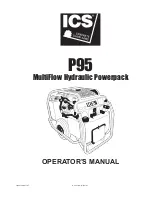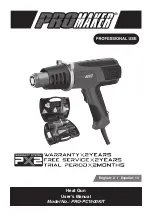
4
Parts & Service: 020 8988 7400 / E-mail: [email protected] or [email protected]
9. NEVER carry the wrench with your finger on the trigger.
10. NEVER abuse the mains cable of the battery charger. Never pull the cable
to disconnect it from the socket. Keep the cable away from sharp edges/
hot surfaces.
11. NEVER use this wrench for any purpose other than described in this booklet.
12. NEVER carry out any alterations or modifications to this product.
13. NEVER wipe the wrench clean with solvents. Wipe plastic parts with a soft
cloth, slightly dampened with soapy water.
14. NEVER attempt any repairs yourself. If you have a problem with this product
contact your local CLARKE dealer.
15. ALWAYS use an approved cable extension suitable for the power rating of
the battery charger (see specifications), the conductor size should also be
at least the same size or larger than that on the charger. When using a
cable reel, always unwind the cable completely.
IMPACT WRENCH SAFETY INSTRUCTIONS
1.
USE ONLY IMPACT WRENCH SOCKETS
....DO NOT use standard sockets which
could shatter and cause injury.
2. ALWAYS
finish tightening nuts with a torque wrench to the correct torque as
recommended by the vehicle manufacturer.
3. ALWAYS
avoid excessive use of the wrench. When tightening a nut or bolt,
always avoid over tightening.
4. ALWAYS ensure the wrench has stopped before putting it down after use.
5. ALWAYS set the forward/reverse selection bar to neutral/lock when
changing sockets or when the wrench is not required for immediate use.
This will avoid accidental starting.
6. NEVER point the LED light at persons or animals.
LITHIUM-ION BATTERY USE AND CARE
1. Only use the wrench with the battery pack supplied. Use of any another
battery pack may create a risk of injury and fire.
2. DO NOT charge the battery when the room temperature is below 5
o
C. DO
NOT store the battery where the temperature may exceed 40
o
C (104
o
F)
3. When the battery pack is not in use, keep it away from metal objects that
could make a connection from one terminal to another. Shorting the
battery terminals together may cause burns or a fire.
4. Dispose of spent batteries correctly as they contain Lithium-ion. They are re-
cyclable and should be taken to a recycling centre to be disposed of as
Summary of Contents for 4500658
Page 16: ......


































